National Hospital
for Neurology and Neurosurgery
for Neurology and Neurosurgery
Queen Square, Bloomsbury, WC1N 3BG
Medical
dates:
Medical
character:
Specialist
The idea of a hospital specifically to care for the paralysed came to Johanna Chandler
and her siblings, Louisa and Edward, after the death of their beloved
grandmother, who had looked after them since they had been orphaned.
The old lady had been paralysed by a stroke for a number of
years, but no instititution catered for such patients.
To raise money for the venture the women made and sold small ornaments decorated with shells and beads. After two years they had raised £200. They also approached the Lord Mayor of London, Alderman David Wire, himself partially paralysed, who expressed sympathy and interest.
The Lord Mayor called a special public meeting on 2nd November 1859, which was held in the Egyptian Hall of the Mansion House with his wealthy and influential contacts in attendance. Some £800 was raised, and the meeting resolved to establish a hospital for paralysed and epileptic patients.
While the Chandlers had wished it to be a place where 'incurables' could be cared for, the Lord Mayor insisted that it should be a special hospital where patients could be investigated and treated, with a possibility of a cure. He became the Chairman of the Hospital Committee, and Edward Chandler its Secretary.
A house in Queen Square (No. 24) was leased at an annual rent of £110 and the National Hospital for the Paralysed and Epileptic opened in the spring of 1860. On the ground floor it had a small Out-Patients Department (in the front and back parlours) and a dispensary (in the butler's pantry). Upstairs was a ward with 8 beds for female patients; a ward for male patients was added in June 1860. Most patients were treated free of charge; those who could afford it, paid 7 shillings (35p) a week towards their keep.
Only potentially treatable patients were admitted, having been assessed by a clinician in the Out-Patients Department. If, after a probationary period, it was decided that an in-patient was incurable, they were discharged into the care of their family, but could be followed-up as an out-patient.
In 1866 the lease for the house next-door, No. 26 Queen Square, was purchased for £3,000 (as was the lease for No. 24). The Hospital then had 36 beds. The ground floor contained the Out-Patients Department, a Board Room, a consulting room, office, dispensary, laboratory, a porter's room and a ward with an adjacent Day Room. On the upper floors were two wards, the bathrooms, an electrical treatment room and gymnasium, and a padded room. Despite their seemingly hopeless states, patients were subjected to a variety of treatment regimes intended to stimulate their torpid muscles - massage, eletrical treatments, sulphur baths, etc.
It was the first hospital to institute Day Rooms - comfortable, carpeted places with flowers, paintings and a Library, where patients could relax away from their wards. It was also one of the first hospitals to have a gymasium and facilities for balneotherapy, to employ male nurses, and to arrange concerts and entertainments for the patients. In the summer, patients were taken on drives to the countryside.
By 1868 the Hospital had 60 beds and, by 1870, 64.
In 1870 a convalescent home opened in East Finchley.
A new ward opened in 1876 for middle-class patients - gentlewomen of limited means, governesses, clerks and the wives and children of businessmen who were unable to afford medical treatment in their own homes, but willing to pay a portion of their maintenance while in hospital.
By 1878 the Hospital was treating some 3,000 patients a year, many of whom proved to be incurable (they were awarded a pension by the Hospital Committee, ranging from £10 to £22 a year).
During the 1880s the two houses were demolished and the Hospital rebuilt. The east wing - on a site in Powis Place, built at a cost of £10,000 - was officially opened in 1881 by Princess Christian. It contained the Out-Patients Department, with a ward on the upper floor. The west wing was officially opened in 1885 by the Prince of Wales (later King Edward VII). It had cost £60,000 to build. Named the Albany Wing, it was a memorial to the Prince's late brother, the Duke of Albany, who had helped secure funds for the building. The Hospital then had 170 beds.
A surgical wing was added in 1891.
In 1904 a new operating theatre was opened by the Duchess of Albany.
In 1909, the Jubilee of the Hospital, following a collection made by the Duchess of Albany, the Out-Patients Department and other departments were enlarged and improved. Electricity and a telephone system were installed. The new extensions were opened by King Edward VII.
During WW1, in 1915, the Hospital became a section of the First London General Hospital; wards with 70 beds were reserved for wounded sailors and soldiers with neurological injuries. King George V and Queen Mary visited in February 1916. In 1917 a Massage School opened in two Georgian houses at Nos. 29 and 30 Queen Square, in conjunction with University College Hospital; it also contained a hostel for students (the houses were demolished in 1937). In 1918, following a request by the Ministry of Pensions, the Hospital Committee assumed responsibility for the management of the 30-bedded Home for Discharged Sailors and Soldiers in Queen Square, Lonsdale House and the Bray Court Hospital for Neurathenic Discharged Sailors and Soldiers in Maidenhead.
In 1926 the Hospital was renamed the National Hospital for the Relief and Cure of Diseases of the Nervous System including Paralysis and Epilepsy.
In 1935 the Rockefeller Foundation offered the Hospital £120,000 towards a new building to house an institute for the teaching and study of neurology, providing it could raise a similiar sum to complete and equip it. The Earl of Athlone, President of the Hospital, immediately launched an appeal to raise the money.
In 1936 Nos. 29 and 30 Queen Square were demolished and, on 30th April 1937, Princess Alice, Countess of Athlone, laid the foundation stone for the new wing to be built on their site.
The Queen Mary Wing was officially opened on 19th July 1938 by the Queen herself. It had been funded mainly by the Rockefeller Foundation and Lord Nuffield, and contained a surgical department and increased research facilities.
In the same year, a new organ was installed in the chapel, financed by an anonymous donor.
As the prospect of war loomed in 1939, a First Aid Post was set up on the ground floor and basement of the new Wing. It was provided by the Holborn Borough Council under the Ministry of Health's emergency wartime service scheme for anticipated civilian casualties from bombing raids.
In September 1940 the new building received a direct hit, causing much damage to the upper floors. In December, Elizabeth Morgan Ward was destroyed by fire from incendiary bombs. Activities had to be curtailed, but surgery was undertaken at other hospitals, especially Hurstwood Park Hospital in Haywards Heath.
By 1943, because of war damage, only 50 of the 229 beds were open. Several Medical Officers of the Canadian Army acted as guest non-resident House Physicians for short periods.
During 1943 some 69 patients were admitted with multiple sclerosis and 48 with epilepsy. The remaining admissions suffered from neuralgia, hysteria, unspecified neurosis, syphilis, sciatica, congenital or acquired syringomyelia, or nerve tumours.
After the war, in 1947 the Hospital merged with the Maida Vale Hospital. Both joined the NHS in 1948 as postgraduate teaching hospitals, named the National Hospitals for Nervous Diseases.
In 1948 the Hospital acquired the lease for Queen Square House.
In June 1963 Alexandra House was opened by Princess Alice, Countess of Athlone. It houses various specialist and research departments.
In 1971 the Queen Mother laid the foundation stone for a new Queen Square House. She returned in 1978 to open the building.
In 1990 the name of the Hospital was changed to the National Hospital for Neurology and Neurosurgery.
During the 1990s the Powis Place Pavilion, built in 1881, was demolished to make way for the Chandler Wing, which opened in 1994.
In 1996 the Hospital became part of the University College London Hospitals NHS Foundation Trust.
In 2001 it had 244 beds.
To raise money for the venture the women made and sold small ornaments decorated with shells and beads. After two years they had raised £200. They also approached the Lord Mayor of London, Alderman David Wire, himself partially paralysed, who expressed sympathy and interest.
The Lord Mayor called a special public meeting on 2nd November 1859, which was held in the Egyptian Hall of the Mansion House with his wealthy and influential contacts in attendance. Some £800 was raised, and the meeting resolved to establish a hospital for paralysed and epileptic patients.
While the Chandlers had wished it to be a place where 'incurables' could be cared for, the Lord Mayor insisted that it should be a special hospital where patients could be investigated and treated, with a possibility of a cure. He became the Chairman of the Hospital Committee, and Edward Chandler its Secretary.
A house in Queen Square (No. 24) was leased at an annual rent of £110 and the National Hospital for the Paralysed and Epileptic opened in the spring of 1860. On the ground floor it had a small Out-Patients Department (in the front and back parlours) and a dispensary (in the butler's pantry). Upstairs was a ward with 8 beds for female patients; a ward for male patients was added in June 1860. Most patients were treated free of charge; those who could afford it, paid 7 shillings (35p) a week towards their keep.
Only potentially treatable patients were admitted, having been assessed by a clinician in the Out-Patients Department. If, after a probationary period, it was decided that an in-patient was incurable, they were discharged into the care of their family, but could be followed-up as an out-patient.
In 1866 the lease for the house next-door, No. 26 Queen Square, was purchased for £3,000 (as was the lease for No. 24). The Hospital then had 36 beds. The ground floor contained the Out-Patients Department, a Board Room, a consulting room, office, dispensary, laboratory, a porter's room and a ward with an adjacent Day Room. On the upper floors were two wards, the bathrooms, an electrical treatment room and gymnasium, and a padded room. Despite their seemingly hopeless states, patients were subjected to a variety of treatment regimes intended to stimulate their torpid muscles - massage, eletrical treatments, sulphur baths, etc.
It was the first hospital to institute Day Rooms - comfortable, carpeted places with flowers, paintings and a Library, where patients could relax away from their wards. It was also one of the first hospitals to have a gymasium and facilities for balneotherapy, to employ male nurses, and to arrange concerts and entertainments for the patients. In the summer, patients were taken on drives to the countryside.
By 1868 the Hospital had 60 beds and, by 1870, 64.
In 1870 a convalescent home opened in East Finchley.
A new ward opened in 1876 for middle-class patients - gentlewomen of limited means, governesses, clerks and the wives and children of businessmen who were unable to afford medical treatment in their own homes, but willing to pay a portion of their maintenance while in hospital.
By 1878 the Hospital was treating some 3,000 patients a year, many of whom proved to be incurable (they were awarded a pension by the Hospital Committee, ranging from £10 to £22 a year).
During the 1880s the two houses were demolished and the Hospital rebuilt. The east wing - on a site in Powis Place, built at a cost of £10,000 - was officially opened in 1881 by Princess Christian. It contained the Out-Patients Department, with a ward on the upper floor. The west wing was officially opened in 1885 by the Prince of Wales (later King Edward VII). It had cost £60,000 to build. Named the Albany Wing, it was a memorial to the Prince's late brother, the Duke of Albany, who had helped secure funds for the building. The Hospital then had 170 beds.
A surgical wing was added in 1891.
In 1904 a new operating theatre was opened by the Duchess of Albany.
In 1909, the Jubilee of the Hospital, following a collection made by the Duchess of Albany, the Out-Patients Department and other departments were enlarged and improved. Electricity and a telephone system were installed. The new extensions were opened by King Edward VII.
During WW1, in 1915, the Hospital became a section of the First London General Hospital; wards with 70 beds were reserved for wounded sailors and soldiers with neurological injuries. King George V and Queen Mary visited in February 1916. In 1917 a Massage School opened in two Georgian houses at Nos. 29 and 30 Queen Square, in conjunction with University College Hospital; it also contained a hostel for students (the houses were demolished in 1937). In 1918, following a request by the Ministry of Pensions, the Hospital Committee assumed responsibility for the management of the 30-bedded Home for Discharged Sailors and Soldiers in Queen Square, Lonsdale House and the Bray Court Hospital for Neurathenic Discharged Sailors and Soldiers in Maidenhead.
In 1926 the Hospital was renamed the National Hospital for the Relief and Cure of Diseases of the Nervous System including Paralysis and Epilepsy.
In 1935 the Rockefeller Foundation offered the Hospital £120,000 towards a new building to house an institute for the teaching and study of neurology, providing it could raise a similiar sum to complete and equip it. The Earl of Athlone, President of the Hospital, immediately launched an appeal to raise the money.
In 1936 Nos. 29 and 30 Queen Square were demolished and, on 30th April 1937, Princess Alice, Countess of Athlone, laid the foundation stone for the new wing to be built on their site.
The Queen Mary Wing was officially opened on 19th July 1938 by the Queen herself. It had been funded mainly by the Rockefeller Foundation and Lord Nuffield, and contained a surgical department and increased research facilities.
In the same year, a new organ was installed in the chapel, financed by an anonymous donor.
As the prospect of war loomed in 1939, a First Aid Post was set up on the ground floor and basement of the new Wing. It was provided by the Holborn Borough Council under the Ministry of Health's emergency wartime service scheme for anticipated civilian casualties from bombing raids.
In September 1940 the new building received a direct hit, causing much damage to the upper floors. In December, Elizabeth Morgan Ward was destroyed by fire from incendiary bombs. Activities had to be curtailed, but surgery was undertaken at other hospitals, especially Hurstwood Park Hospital in Haywards Heath.
By 1943, because of war damage, only 50 of the 229 beds were open. Several Medical Officers of the Canadian Army acted as guest non-resident House Physicians for short periods.
During 1943 some 69 patients were admitted with multiple sclerosis and 48 with epilepsy. The remaining admissions suffered from neuralgia, hysteria, unspecified neurosis, syphilis, sciatica, congenital or acquired syringomyelia, or nerve tumours.
After the war, in 1947 the Hospital merged with the Maida Vale Hospital. Both joined the NHS in 1948 as postgraduate teaching hospitals, named the National Hospitals for Nervous Diseases.
In 1948 the Hospital acquired the lease for Queen Square House.
In June 1963 Alexandra House was opened by Princess Alice, Countess of Athlone. It houses various specialist and research departments.
In 1971 the Queen Mother laid the foundation stone for a new Queen Square House. She returned in 1978 to open the building.
In 1990 the name of the Hospital was changed to the National Hospital for Neurology and Neurosurgery.
During the 1990s the Powis Place Pavilion, built in 1881, was demolished to make way for the Chandler Wing, which opened in 1994.
In 1996 the Hospital became part of the University College London Hospitals NHS Foundation Trust.
In 2001 it had 244 beds.
Present status (October 2014)
Today the Hospital is known as the National Hospital for Neurology and Neurosurgery, the largest of its kind in the United Kingdom.
Queen Square is almost entirely given over to buildings providing health care - investigation, treatment or research. The east side contains the Hospital and the Royal London Hospital for Integrated Care (formerly the Royal London Homoeopathic Hospital). The former Italian Hospital on the south side is now part of the Great Ormond Street Hospital for Children. The west side contains several buildings for medical research belonging to University College London. The Institute of Neurology is located on the northeast corner of the square.
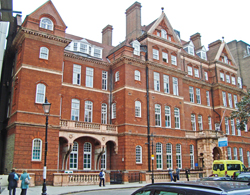
The Albany Wing, at Nos. 25-32 Queen Square, opened in 1885.

The main entrance to the Hospital.
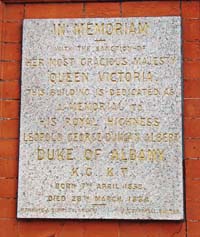
A plaque dedicating the building to the Duke of Albany, who died in 1884.
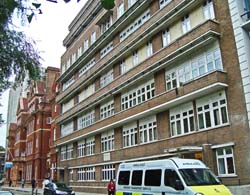
The Queen Mary Wing opened in 1938.
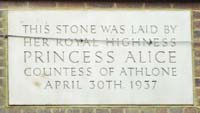
The foundation stone for the Queen Mary Wing.
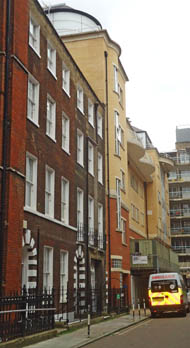
The Chandler Wing in Powis Place opened in 1994.
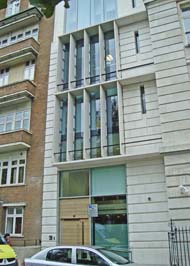
A new building at No. 33 Queen Square links the Hospital to the Royal London Hospital for Integrated Care.
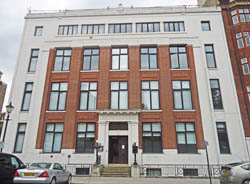
The former Institute for Public Health, on the northern side of Queen Square, at No. 23, now contains offices for the Hospital and the Institute of Neurology.
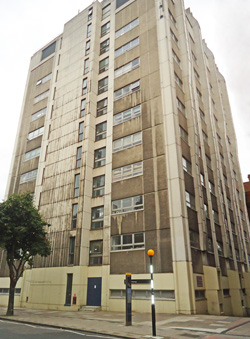
Queen Square House was built in the 1970s and houses most departments of the Institute of Neurology.
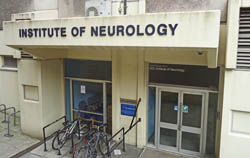
Its entrance is at the lower ground level.
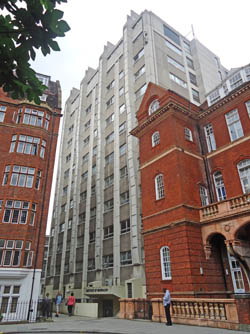
Queen Square House is located to the northeast of Queen Square, just to the north of the Albany Wing (seen on the right).
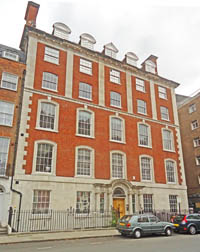
Alexandra House at No. 17 Queen Square, a tall neo-Georgian building, contains the Institute of Cognitive Neuroscience and the Gatsby Computational Neuroscience Unit.


St John's House at No. 12 Queen Square, once the home of a Church of England training institute for nurses, now houses the Wellcome Trust Centre for Neuroimaging (the Functional Imaging Laboratory) (left). A statue of St John the Evangelist holding a chalice with a snake is inset into the building's fascia.
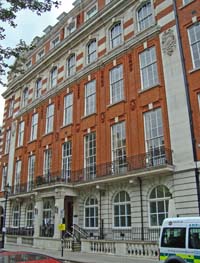
Charles Symonds House at Nos. 8-11 Queen Square, a former medical examination hall, contains the Centre for Neuromuscular Diseases and the Dementia Research Centre.
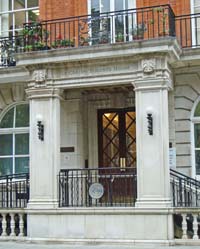
The entrance to Charles Symonds House.
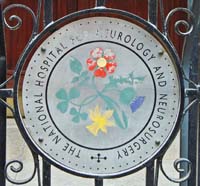
A roundel with the logo of the Hospital on the railings of Charles Symonds House.

No. 7 Queen Square contains offices for the Institute of Neurology.
(Author unstated) 1896 Comments and replies. Nursing Record and Hospital World, 31st October, 368.
(Author unstated) 1904 Reflections from a Board Room mirror. British Journal of Nursing, 17th September, 237.
(Author unstated) 1908 Reflections from a Board Room mirror. British Journal of Nursing, 25th April, 336.
(Author unstated) 1909 Comments and replies. British Journal of Nursing, 21st August, 167.
(Author unstated) 1909 Reflections from a Board Room mirror. British Journal of Nursing, 30th October, 367.
(Author unstated) 1917 List of the various hospitals treating military cases in the United Kingdom. London, H.M.S.O.
(Author unstated) 1935 The Hospital World. British Journal of Nursing (November), 305.
(Author unstated) 1960 Queen Square and the National Hospital, 1860-1960. London, Edward Arnold.
Clarke C, Shovron S 2011 The 'National' reflects on its 150-year legacy. World Neurology 26, 4
Critchley M 1960 The beginnings of the National Hospital, Queen Square (1859-1960). British Medical Journal 1 (5189), 1829-1837.
Holmes G 1954 The National Hospital, Queen Square, 1860-1948. Edinburgh, E. & S. Livinstone.
Scott A, Eadie M, Lees A 2012 William Richard Gowers 1845-1915: Exploring the Victorian Brain. Oxford University Press.
http://archiseek.com
http://en.wikipedia.org (1)
http://en.wikipedia.org (2)
http://queensquare.co.uk
www.british-history.ac.uk
www.ion.ucl.ac.uk
www.queensquare.org.uk (1)
www.queensquare.org.uk (2)
www.ucl.ac.uk (1)
www.ucl.ac.uk (2)
www.uclh.nhs.uk (1)
www.uclh.nhs.uk (2)
Return to home page